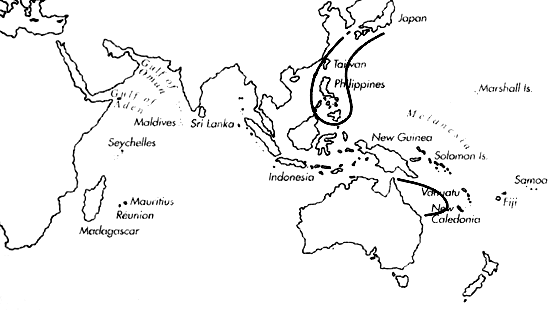Range: Japan to Philippines; Queensland and Coral See.
Description: Moderately large to large, usually solid. Last whorl conical to ventricosely conical or slightly pyriform; outline convex at adapical fourth to half, straight or slightly concave below. Shoulder angulate. Spire low; outline concave to sigmoid, often with early whorls projecting from an otherwise flat or slightly domed spire. Larval shell of about 3 whorls, maximum diameter about 1 mm. First 3-5 postnuclear whorls tuberculate. Teleoconch sutural ramps flat to slightly concave, with 1 increasing to 5-8 spiral grooves, sometimes with additional spiral striae in latest whorls. Last whorl with weak to distinct spiral ribs and ribbons at base.
| Shell Morphometry | ||
|---|---|---|
| L | 60-103 mm | |
| RW | 0.30-0.85 g/mm | |
| RD | 0.54-0.62 | |
| PMD | 0.80-0.94 | |
| RSH | 0.02-0.11 | |
Ground colour white. Last whorl immaculate or variably shaded with yellow or tan; shells from Philippines may have additional brown axial streaks spirally aligned just above centre; shells from Queensland may additionally be suffused or banded with very pale violet. Larval whorls white or beige. In Japanese and Philippine shells, early teleoconch sutural ramps may be tinged with yellow. Outer margins of sutural ramps sometimes with a varying number of brown dots, persisting at edge of shoulder in some specimens. Aperture white, sometimes bluish white.
Periostracum yellow-olive to brown, rather thin and opaque, with a variably fringed shoulder.
Habitat and Habits: In 200-400 m.
Discussion: C. sugimotonis resembles C. tribblei, C. lenavati and C. sieboldii. C. tribblei differs in the variable brown spiral bands on its last whorl, the brown radial markings on its sutural ramps, its carinate late whorls, and its generally narrower last whorl (RD 0.47-0.61) with an almost straight rather than slightly sigmoid outline. The spiral sculpture is weaker on the late sutural ramps of C. tribblei but stronger on its last whorl. C. lenavati can be distinguished by its brown spiral bands and axial blotches on the last whorl, brown flecks rather than dots on the sutural ramps, and the weaker spiral sculpture of its late sutural ramps. For comparison with C. sieboldii, see the Discussion of that species.

C. sugimotonis range map
This section contains verbatim reproductions of the accounts of 316 species of Conus from the Indo-Pacific region, from Manual of the Living Conidae, by Röckel, Korn and Kohn (1995). They are reproduced with the kind permission of the present publisher, Conchbooks.
All plates and figures referred to in the text are also in Röckel, Korn & Kohn, 1995. Manual of the Living Conidae Vol. 1: Indo-Pacific Region.
The range maps have been modified so that each species account has it own map, rather than one map that showed the ranges of several species in the original work. This was necessary because each species account is on a separate page on the website and not confined to the order of accounts in the book.